INTRODUCTION
Growing up near Big Sur & Monterey, you tend to volunteer at, work on, or sneak into some pretty incredible events.
- I've sold Ice Cream at the Indy Car Races in Laguna Seca
- Worked a few catering gigs at the Concours d'Elegance
- Watched the Pebble Beach Pro Am from the mansions I did construction on in high school
- Snuck into the Monterey Jazz Festival
- Volunteered at the Salinas RodeoMet Tone Loc backstage at the Seaside Rap Festival (pretty cool)
- And we used to camp near the course on Big Sur Marathon Weekend
So... when we started this series, there were definitely a few events on my hit list and the Marathon was one of the top. Getting the chance to sit down with Doug Thurston, Race Director of the Big Sur Marathon was pretty special.
Here's a little glimpse at our conversation:
- What he initially focused on when being hired to take over an organization so steeped in tradition.
- What it's like to deal with one of the toughest things a race director could go through.
- The impact of technology and it's evolution in the sport.
- The difficulty of forecasting and its potential impact on a participant's experience.
Enjoy the interview.
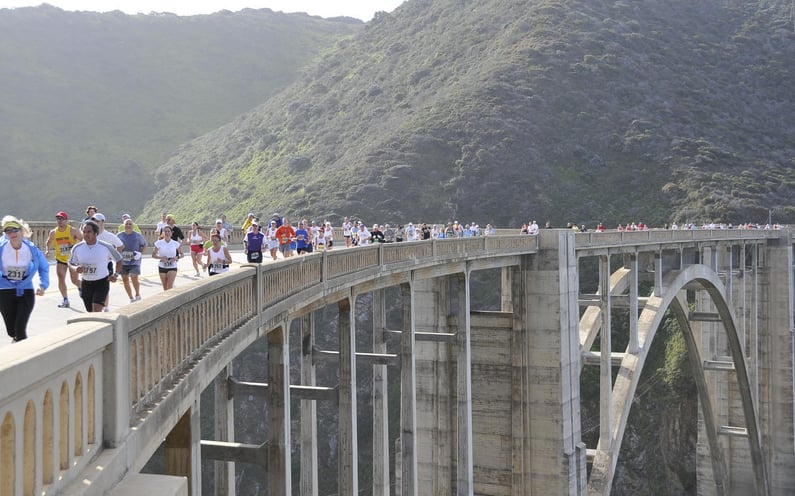 Photo Cred: the Big Sur Marathon team at the Bixby Bridge
Photo Cred: the Big Sur Marathon team at the Bixby Bridge
Where did you grow up?
Born in Oklahoma, but grew up in Southern California.
Big Family, Small Family?
I am the youngest of four children.
So who is Bentley?
Bentley is my 16 pound, friendly, boy cat.
He kind of looks like Garfield?
Yeah, that is correct. Kind of a Garfield. I bring him into the office a couple days a week. He usually lays around on the keyboard, stretches and takes naps around the office. He definitely entertains himself in the office.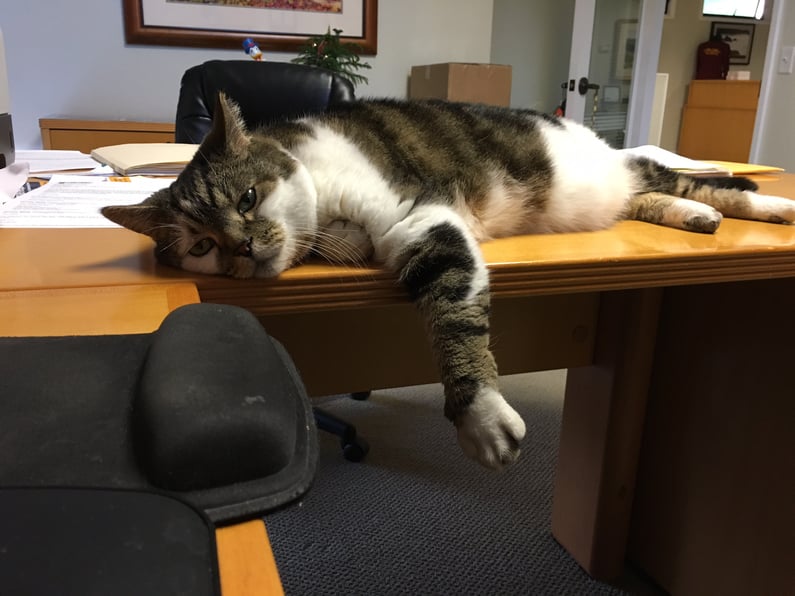
Photo Cred: The Big Sur Marathon mascot Bentley
If your friends were a little tipsy, how would they describe you?
Tall and serious.
So would they describe you as “Cookie Monster”?
Wait… I didn’t realize my staff was in on this.
Sorry Doug, I am not at liberty to reveal my sources?
It’s a conspiracy!
I mean, if the shoe fits, right?
Photo Cred: Susan Love.
Well I have to admit, I definitely have a sweet tooth. And if Sesame Street was around when I was growing up, he would have been one of my favorite characters.
You’ve been in the events business for over 30 years, that’s incredible:
About 33 yeah.
So, when someone does anything for that long, how do you think they maintain the passion for what they are doing?
Well for one, they probably don’t keep track of how long. :) Because if they do, it might get depressing. My family is still like, when are you going to get a real job. A normal job.
I think just always knowing it is someone’s first race, goal race, best race. Just providing that environment so someone else can succeed is what keeps us all going. Because it’s hard, hard work doing what we do.
Because you work all week and many weekends and you deal with a lot of pressure and stress. So if you don’t have some motivation and the motivation is seeing other people perform. We really try to create the environment where people can meet their goal and accomplish their dream. So making dreams come true is a huge factor for us and a pretty powerful business to be in.
And If you weren’t in the event business, what would you be doing?
Well my educational background is in Journalism. I’ve worked as a sports editor and in public relations, so I imagine I would still be in the sports field, just not in the race director position.
Photo Cred: Oklahoma Runner Magazine
Word in the office is, you can be heavy handed with the red pen.
I do have a journalism background, so I do a lot of editing. Communication is important to me.
Oh shit! I hope you haven’t read any of my interviews.
No I’ve read a number of them.
Annnnd…
Oh they were fine.
From an editor… I’ll take fine. I’m not scared.
How did you get into running?
Well I became a sports editor for a small paper in Oklahoma and then did Public Relations work in Texas and then started to run road races.
Which I understand you’ve done just a few.
Yeah I think it’s like 6 or 700, I can’t keep track anymore.
Ya think! Hooooly crap!
Well, that’s over 30 plus years.
Doug... Are you really trying to downplay that number?
I know. I really enjoy them though.
And that is why you’re the Race Director for the Big Sur International Marathon.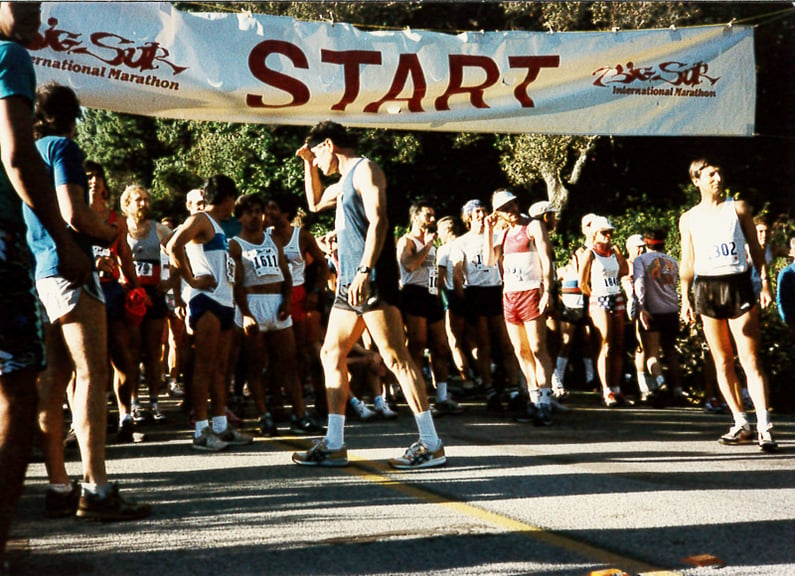
A photo of Doug (right) or someone that looks like Doug at the start of the 1986 Big Sur Marathon
How has your background in media impacted your approach to your job now?
I was an old guard journalist, before the internet, before social media. Basically ink-stained print journalist. So now of course that has changed. But I guess my background in journalism helps me communicate with the press. I know they are looking for a story and looking for the facts, so I’d say I’ve been able to work with them pretty well in that way.
When you think about the entire event production process what is your favorite part?
Definitely seeing people at the finish line. Particularly the first timers. Seeing them accomplish something they didn’t know they could do. Your life does change at the finish line of a marathon or half marathon or even a 5K if it is your first one. So knowing that we had a little role in that is pretty exciting.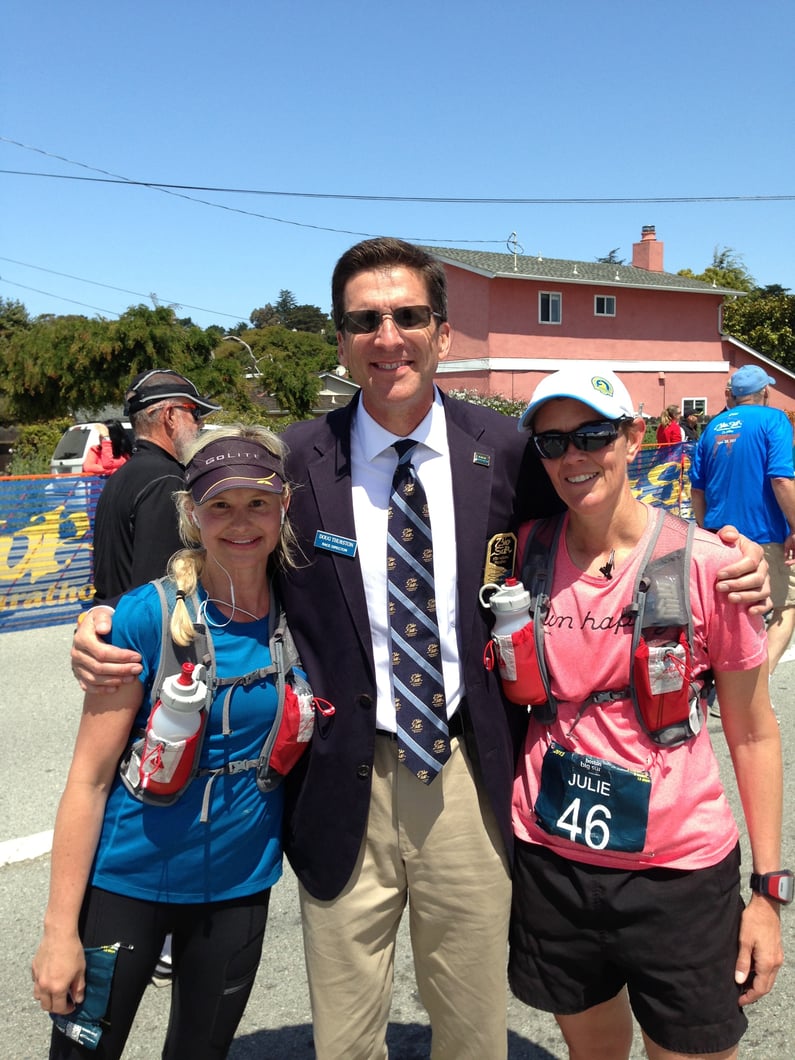
Knowing your skill set, what is your least favorite part of the process?
The hardest part is when you disappoint someone. Maybe you miss-judged your shirt order. When someone who registered months before comes to the race and says “what do you mean, you don’t have my shirt”. Or medal. Or all kinds of things like that. It’s really tough.
It’s tough because there’s really a balance between ending up with 2000 additional shirts left over or potentially running out by 15. And it’s a tough conversation to have with those 15 people. Medals are the same.
So in that situation, what do you do?
You just try and empathize and say you’re really sorry and try to make it up to them. Get another shirt to them as soon as you can. If something I have done affects their ability to enjoy the race, then it’s the most difficult part.
What is one of the hardest things you have to deal with as an event director?
It’s always difficult when you lose a runner. When you have to talk to their friends and family, it’s extremely tough. It’s very rare, but it happens. But most race directors have to deal with it.
So how do you bounce back from that?
You talk to the family and empathize with them and also look to make sure you did everything you could to ensure for a safe event. But you honestly focus on sympathizing with the family. And most of the time, the family says “he or she was doing what they loved and it was just fate”.
Wow. I can only imagine how tough that is.
It is a very tough thing to deal with, but comes with the job.
How much do you think about innovation versus consistency and maintaining the incredible tradition the BSIM has created over the years?
A lot of time is spent on both. It is a bucket list event. So that also means that when people check it off their bucket list, sometimes they don’t come back. So my turn-over is very high. So I have to find 80% new audience every year. So we’re always looking at new ways to market, new ways to promote, tracking our demographics, who’s running now. So a big question for us is how do we make the Marathon seem accomplish able, yet still challenging.
We’re also trying to stay on the cutting edge of other things. Whether it’s public safety, medical safety or even just the appearance. You know, when you have such a beautiful course, we’re not responsible for that beauty, but we are responsible for the beauty of our start-line banner system, or our race shirts, or our bibs or medals. So we want to have every part of our race be as beautiful as our course.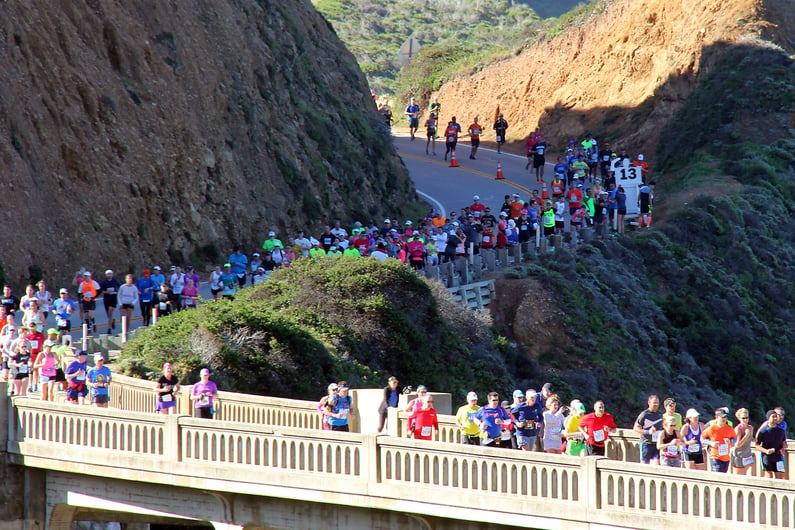
Photo Cred: The Big Sur Marathon Team
What major technology changes do you think we’ll see in the industry over the next 10 years?
I think it will continue to develop more about runner tracking. Not just about where they are on the course, but also about the runner’s experience. I think we’ll start to see automatic posting and more of a virtual experience for the friends and family of the runners in real-time.
So are you interested in things like GoPro and Periscope?
I am definitely interested in things like GoPro, because that documentation as a bucket list event is very intriguing. Our race is a lot like the Grand Canyon, you can see it in pictures, but until you see it on race day, even seeing a video doesn’t replicate the majesty of the event. It’s more than just the sites though, it’s the sounds and smells of saltwater and waves crashing, the wind. So even just seeing it in video doesn’t fully do it justice so, I really think the real-time immersive type experiences for supporters is going to be really interesting.
Is there anyone you reach out to today in the race community to share ideas or advice?
I think that’s one of the things that keeps me coming back after all these years is the collaboration that occurs at something like the RunningUSA Conference. Whether it’s Mike and Carrie in Chicago, Peter in New York, Dave and Tom in Boston, Tracy in LA, Virginia in Twin Cities, honestly any time you call they answer. We realize that if we can help all of our events get better, than it helps the sport.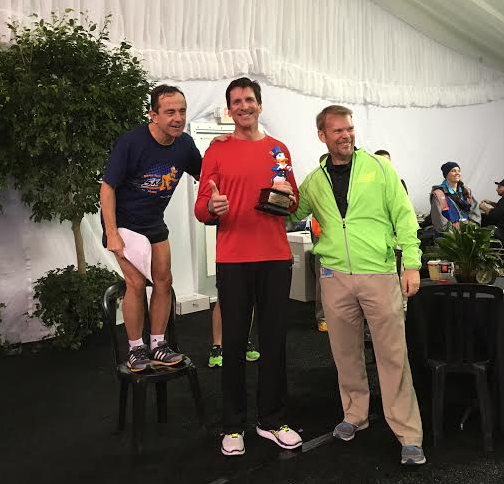
Doug with some of his race director buds: Dave McGillvray (Left) and Faron Kelly (Right)
So what do you think is your biggest competition?
There are so many bucket-list races for distance runners: Boston, New York, Chicago, London, etc. But I don’t really think of those races as competition as there seems to be high demand for all of them. I think our greatest competition might be the runner’s expectations for our event. The Big Sur Marathon is such a different experience than other well-known races: we are so much smaller, so rural, so natural, and with so few spectators or block parties. Running our race is a different sensory experience then these other great races. It’s more like a long run in a beautiful area with thousands of friends than a race for many people.
What career advice would you give your 22 year old self?
I'd say to try and keep some balance in your life. Because it’s really easy as a Race Director to lose your balance within your life. Race directing is one of those jobs where the more time you give it and the harder you work, sometimes the better your product is. So no-one keeps you from overworking.
I’d also say, do other things besides just put on races and run races. We don’t get in trouble talking about running. It’s our job. We don’t have a regular job. It’s ok if we read running magazines at work. That is our job. But that also means it’s hard to keep balance.
When you were hired in 2013, you were coming into something that is steeped in tradition.
Yeah. It was obviously one of the things I was really excited about.
So, what were the first few things you concentrated on when joining the team?
The first thing I to do was a lot of listening. I knew it was a rare opportunity to come into a race that had such a great reputation. And slowly I would bring in suggestions from my past experience, but I kept concentrating on the idea of improving the runner experience. We wanted to create an experience that is as worthy as our course.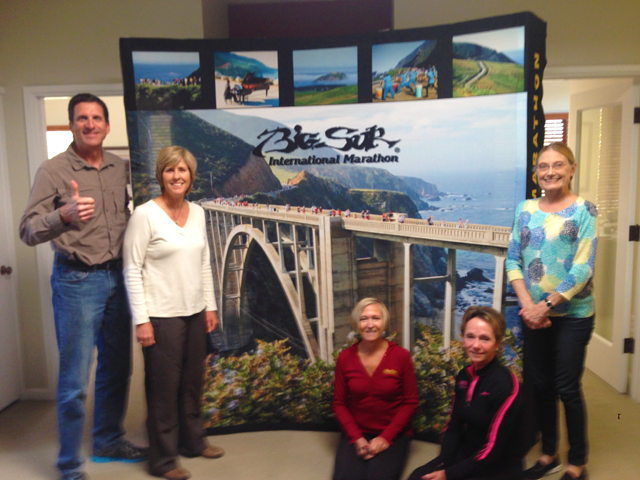
In your work life are you insecure about anything?
My staff may say differently :), but I have a lot of ideas and they don’t all work, but I am definitely not scared to try something.
What was the last book you gifted or recommended to someone?
I tend to like a lot of stories about personal journey’s and I love biographies. One of the best sports books I have read is the book by Andre Agassi. What an amazing story.
Parting Wisdom?
One of the things about this community is that people don’t stay in it long, if they don’t figure out that it is all about the runner experience. And if we can’t help runners meet their dream, then usually people don’t stay long in the industry.
That’s the philosophy that I try to keep “help people try to meet their dreams”.
MY TAKE-AWAY
What I realized very quickly in my time with Doug and his team, is that they want to do everything possible to share their knowledge and experience (even to some crazy local using his mom as bait to get the interview). The sport of running is truly lucky to have someone like Doug Thurston and his team. He's the type of ambassador and mentor you want and need in any industry. So if you're a race director and you haven't spent time with Doug, I hear Big Sur is not a bad place to visit.
UPCOMING INTERVIEWS
Virgin Sport: Victoria Brumfield, VP of Global Operations 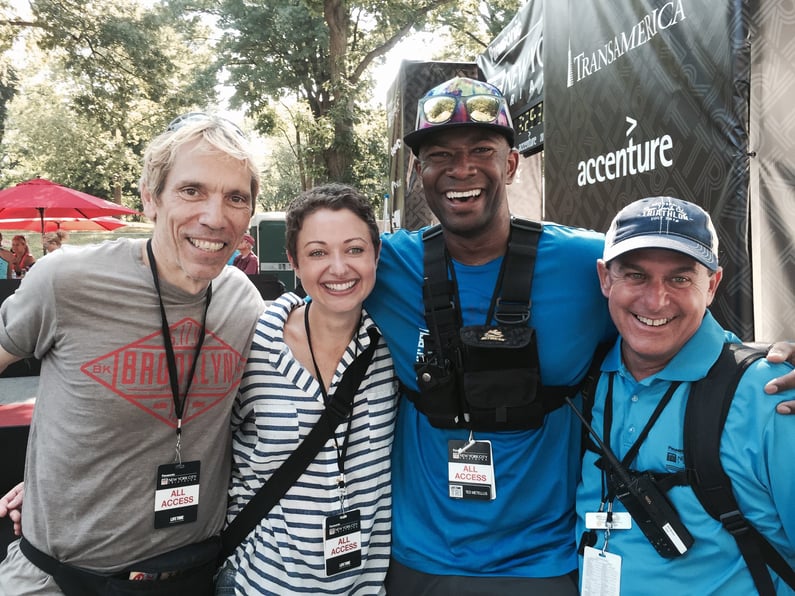
Supefly Entertainment (Bonnaroo): Kat Tooley, Senior Director, Event Production
Ironman: Roch Frey, Event Director
NFL: Katie Keenan, Director of Events
Los Angeles Marathon: Murphy Reinschreiber, VP of Operations
Firefly Music Festival: Megan Marshall, Assistant Director
Ragnar Relay: Tanner Bell, Co-Founder & President
SXSW Interactive: Chris Valentine, Start-Up Village Director
Marine Corp Marathon: Rick Nealis, President
iHeartMedia: Gayle Troberman, EVP & CMO
Beats By Dre: Jason White, VP of Marketing
Sea Otter Classic: Frank Yohannan, Founder & President
WHAT IS LENND
Lennd is an operations and workforce management platform for events. We're currently in a private beta with some of our favorite events around the globe, but if you want to sign up for early notice as we bring on more events and organizations, you can do that here.



